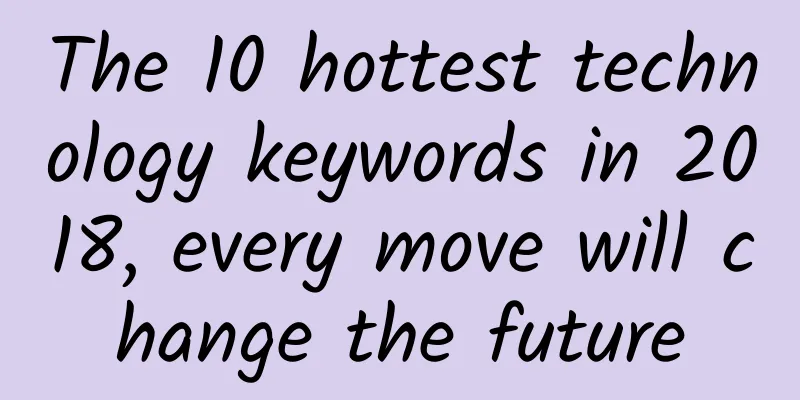The 10 hottest technology keywords in 2018, every move will change the future

|
The end of 2017 is accompanied by the arrival of the new year. Many technologies have matured this year and are likely to develop more steadily in 2018. What are the technology trends worth noting in 2018? Let's take a look at the top ten technology keywords in 2018. 2017 is a year of rapid development for human technology, from AI artificial intelligence to driverless cars, from the development of the Internet of Things to voice-controlled devices entering homes, or the technical renovation of mobile phones from the inside out, from full-screen mobile phones to facial recognition unlocking, and then the latest 5G high-speed network will be added. In addition, the new Micro LED display technology is also expected to bring another new world to mobile device panels. A new revolutionary era of mobile phones is coming. On the other hand, the technological development of the virtual world is also worth watching. In 2017, augmented reality is the leading technology. Does the newly emerging mixed reality have a chance to become a dark horse? Finally, what is the blockchain technology that is currently attracting much attention in the financial industry? 1. Artificial intelligence will become the main battlefield In May this year, the "man-machine game" between Google DeepMind's artificial intelligence AlphaGo and world chess champion Ke Jie was launched, attracting the attention of many global Go enthusiasts. At the same time, many technology companies also attached great importance to this competition. In the end, AlphaGo easily defeated chess champion Ke Jie, proving that the computing power of AI artificial intelligence can indeed surpass that of humans; and at the Computex 2017 conference held in Taipei in the middle of this year, various technology companies also exhibited AI robots on site, attracting the attention of many media and the public.
Today's AI has just jumped out of the laboratory experimental stage. The current development is very similar to the Internet that was just budding in the early 1990s. Although there will be infinite applications to look forward to in the future, everyone is still confused about it and does not know where to start. The impact of AI on the future will be divided into two levels. One is the transformation of products and services themselves, and the other is the use of AI in production processes, management and business processes to promote industrial upgrading. The well-known authoritative international research and investigation organization Gartner also named that all walks of life will be affected by it, from electronic components, network communication industry, semiconductors, to the automotive industry and robots. 2017 can be said to be the year when AI shined. In 2016, the World Economic Forum (WEF) regarded AI as the core of the "Fourth Industrial Revolution". When Gartner published the top ten strategic technology trends in 2018, it listed AI as one of the most important technologies in 2018 and stated that all AI-based business models and solutions are in continuous innovation. In the next five years, how to make AI and machine learning penetrate into human life will be the main battlefield for all technology companies. 2. “Unmanned vehicles” are becoming more mature Autonomous driving technology appeared as early as 1980. Today in the 21st century, autonomous driving technology has made great progress and related industries have sprung up like mushrooms after a rain. Some people in the automotive industry predict that autonomous driving is expected to be popularized before 2030. Whether it is a regular private car or an unmanned public transport vehicle, driverless cars are the hottest topic in the automotive industry in 2017. Recently, Taipei and Kaohsiung have begun testing driverless buses. However, due to the strict regulations on "vehicles" in the current law, which require steering wheels and a specified number of escape doors, it is impossible to apply for a test license or conduct general road tests, which has caused doubts that the regulations cannot keep up with the development of technology. In view of this, the transportation department has officially amended the law and announced that it will establish relevant legal sources and management points for driverless cars by the end of the year.
▲ The unmanned autonomous electric bus EZ10 was tested in Taipei in the middle of the year. The Vehicle Testing Center ARTC said that if unmanned vehicles are to be successful, in addition to following relevant regulations, they must also be equipped with their own sensing technology, positioning technology, and decision-making technology. Sensing technology means that the vehicle must be able to detect the surrounding conditions in real time while driving, positioning technology means that it can actually send passengers to the designated location, and decision-making technology means combining the above technologies to make appropriate judgments. In fact, countries around the world are all rushing to the concept of "unmanned vehicles", especially many technology companies and automobile manufacturers have invested in the research and development of unmanned vehicles, such as Google, Apple, Uber, Tesla, B&W, etc. Among them, Tesla's "Autopilot" vehicles, which have been officially mass-produced, are the most advanced. Although it is not yet possible to achieve true unmanned driving, Tesla's autopilot can already predict land traffic conditions and improve driver safety. In addition, Tesla recently launched an electric truck with "platoon driving" technology, claiming that multiple trucks can "automatically" follow the leading vehicle.
▲ Tesla's new electric truck. Coincidentally, when Tesla launched its new electric truck, Uber said it was developing unmanned trucks. "In the future, self-driving trucks will work together with manual drivers. Self-driving trucks will be responsible for major long-distance transportation, while truck drivers will be responsible for delivering the goods to the final destination." Gartner said that judging from the current development of driverless cars, there will be a chance to see driverless cars driving on the road under conditional restrictions, detailed regulations and controlled conditions before 2022, but general-purpose self-driving cars may still need a driver at the driver's seat for at least the next five years to prevent unexpected technical failures. 3. The “Internet of Things” is fully launched The Internet of Things is a new technology service that countries around the world are working hard to promote. The "2017 World Internet of Things Expo" hosted by China just ended a while ago. Luo Wen, Vice Minister of China's Ministry of Industry and Information Technology, said that the market size is expected to exceed US$100 billion in 2018, and the number of global connected devices in 2021 will reach 28 billion, of which 16 billion will be related to the Internet of Things. The Internet of Things has become one of the future development trends recognized by the world. It is gaining popularity in society at a very fast speed, changing the industry and bringing it to a new height. In the coming 2018, the number of IoT devices will continue to increase. This refers not only to mobile phones and laptops. We will come into contact with more and more smart devices in our daily lives, such as smart doors, smart door locks, etc. The increase in number will expand the process of using the Internet of Things and make it more accurate. In addition, the scope of use of mobile devices will also be wider. In this process, in order to connect with the increasing number of smart devices, people must have personal devices for managing smart homes. Smartphones will play an important role at that time. The security issue that people are most concerned about in the development of the Internet of Things is actually the most important part of the technology industry when developing the Internet of Things. Especially nowadays, network hacking and ransomware incidents are frequent. Once a large number of devices using the Internet of Things appear, whether it will cause serious problems is also an important topic of discussion. Therefore, before realizing all innovative Internet of Things plans in real life, potential security vulnerabilities must be considered first. Ensuring data security will be the top priority in the promotion and popularization of the Internet of Things in the future. 4. Voice assistants enter the home Smart speakers have been the hottest topic in the voice-controlled devices industry in the past two years. In 2016, Google launched Google Home, which attracted much attention from the industry. This year, Google launched Google Home Mini. Although it is named "Mini", it has almost all the functions of Google Home. By connecting to many home IoT products, users can check the status of their home through simple voice commands. On the other hand, Amazon is not to be outdone. Amazon Echo, which has been in operation for many years, has also been continuously evolving and improving. When paired with voice assistant Alexa, it can achieve the same effect as Google Home and is widely popular.
▲ Google Home launched by Google. To date, the field of smart speakers has been full of contention in 2017. Clova, an artificial intelligence assistant developed by LINE, combines the content and services of LINE, the largest messaging platform in Asia Pacific, and NAVER, the largest search engine in South Korea. In July this year, LINE began to launch a trial version of its own smart speaker Clova WAVE. In addition to voice control functions, it also adds functions such as divination, news reading and TV remote control. The official version has more functions. Not only can it read and transmit LINE messages of specific groups, but users can also have daily conversations with Clova. On the other hand, search engine Baidu has been reported to launch its own smart speaker since last year. A few days ago, it finally made its official debut and launched the $256 smart speaker Raven H. Smart speakers are one of the important industries that all manufacturers want to compete for in 2017. With the booming development of the Internet of Things, smart homes will become a new trend in the future. From the era of replacing keyboards with mice to the present, smartphones have become the most important mobile devices in people's lives. In the future, smart butlers will free hands and complete daily tasks through voice recognition and sound feedback. Jarvis assistant in the future movie "Iron Man" may no longer be just a dream! 5. Smartphone “biometrics” Apple's flagship iPhone X is equipped with the highly anticipated facial recognition unlocking system Face ID, which has attracted the attention of many industries and the general public. However, this is not the first time that we have heard of facial recognition technology. Face++, founded in 2011, Yitu, founded in 2012, and SenseTime, founded in 2014, all provide mature facial recognition solutions, which are mainly used in security protection, access control, retail and other fields. Like Apple's Face ID, the main function of these facial recognition solutions is to limit permissions and ensure security. After Apple officially applies facial recognition to smartphones, other mobile phone manufacturers will follow this trend in the future. In fact, just recently, OnePlus launched its latest flagship phone, the OnePlus 5T, which also has a facial recognition system. According to foreign media tests, the face unlocking speed of the OnePlus 5T is much faster than that of the iPhone X. It can be seen that mobile phones equipped with facial recognition will be more accurate in the future. When fingerprint recognition Touch ID first appeared on the iPhone 5s, it actually faced the same problem: technological improvement. This problem also applies to facial recognition. The "first generation" features newly launched by mobile phone manufacturers often play the role of leaders, and subsequent improvements will be the focus of improving convenience in life. Today, biometric systems are used in smartphone security functions. After fingerprints and faces have been used, what will be the next security key? Recently, it was reported that an assistant professor at the State University of New York has found a new way to unlock mobile phones: "sweat". Sweat is unique to everyone, and mobile phones or other wearable devices can continuously learn the uniqueness of sweat and establish the ability to recognize the user's sweat to help unlock. They even expect that it may be possible to put "sweat ID" into actual commercial use in the next five to ten years. When fingerprints, faces, irises, voices, signatures, and even sweat can now be used as biometric conditions for unlocking smartphones, it is very exciting to see what kind of "special" biometric solutions will appear in 2018. 6. "Full-screen" mobile phones are becoming popular, and dual-screen mobile phones are emerging Full-screen borderless phones became synonymous with premium flagship phones in 2017. Whether it is an Android flagship or the current iPhone X, the borders of the phones are made as narrow as possible. If there are still flagships that do not adopt a full-screen design, they will be discussed and even criticized. The introduction of new technologies and concepts is often accompanied by high prices. Currently, although most full-screen mobile phones are flagship-level, after 2018, full-screen phones will be "downgraded" to mid-level phones and begin to become popular. People will no longer need to spend a lot of money to enjoy the visual experience of borderless phones. When full-screen phones become popular, where will the next high-end smartphones go? What new gimmicks should be introduced to promote buying and even lead the market? The next step for Android manufacturers may be dual-screen phones. According to DigiTimes, citing industry sources, in order to compete with large-screen phones such as the iPhone 8 Plus, many Android phone manufacturers, including Huawei, OPPO, and Samsung, are interested in launching phones with dual-screen folding designs. Huawei Consumer Business Group CEO Richard Yu once said that the company is developing its own dual-screen device, which is expected to debut before the end of 2018. There are also reports that other Chinese manufacturers such as OPPO are also actively submitting patent applications. In addition, Samsung has also submitted a patent application for a folding smartphone in the United States. The company has been working on a prototype in April this year, which may become a folding version of the Galaxy Note.
▲ The picture shows the dual-screen mobile phone Axon M launched by ZTE. The biggest advantage of dual-screen mobile devices is that they can provide a better user experience in multitasking, such as opening different applications on the two screens or providing a larger screen input space, and easily viewing various contents in large-screen mode. However, its disadvantages are also obvious. The biggest problem is that the hinge mechanism connecting the two screens is easy to damage, there will be a gap and a running border between the two screens, etc. The latter is especially obvious when watching videos. In addition to dual-screen mobile phones, in fact, bendable screens have always been the key to the research and development of mobile phone manufacturers. In September this year, foreign media broke the news that Samsung's first foldable smartphone in the Galaxy series, the "Galaxy X", which uses a bendable screen, has recently passed the official certification of South Korea's RRA. The market currently speculates that the Galaxy X is likely to be officially unveiled at the 2018 CES Consumer Electronics Show held in the United States from January 9 to 12 next year.
Although there are no official hardware specifications and appearance designs for dual-screen phones and bendable phones, we can expect that after the emergence of full-screen phones, the changes in mobile phone screens will be more "flexible" in 2018. 7. The first year of 5G high-speed network On October 31, 2017, Intel senior vice president and general manager of the Network Platforms Division Sandra Rivera officially announced that Intel will provide 5G network support for the 2018 Pyeongchang Winter Olympics in South Korea. Sandra pointed out that Intel will provide users and enterprises with unlimited bandwidth access at gigabit speeds, ultra-low latency audio and video distribution, and immersive high-quality content. Intel said that as smartphones and more mobile devices continue to evolve, 5G has officially become one of the most influential technological changes. Through the partnership with the International Olympic Committee, Intel will allow everyone to understand and experience the future 5G technology. As the Pyeongchang Winter Olympics in South Korea will showcase 5G technology, 2018 will become the first year of 5G. It is expected that mobile operators in various countries will adopt 5G technology with a more positive attitude. Research organization CCS Insight estimates that as operators in various countries accelerate the deployment of 5G commercial networks, the speed of 5G popularization will surpass previous generations of mobile network technology. Compared with 4G mobile communication technology, 5G provides faster data transmission rate (theoretical download speed reaches 5Gbps), expands wireless communication coverage area and reduces network waiting time, and expands in vertical industries such as industry, transportation, and medical care in addition to consumer applications. According to the analysis of the research associate of TrendForce, Japan and South Korea are currently the most active in 5G commercialization. In addition to South Korea's display of technology at the Winter Olympics, the Tokyo Olympics in July 2020 will also serve as a stage for Japan to showcase 5G technology. Although many telecom manufacturers around the world are actively promoting the development of 5G networks and have relevant stages to showcase them, there is still no clear time point to explain the schedule for 5G services. Until Qualcomm held a 4G/5G summit a few days ago and announced the launch of the world's first 5G modem chip platform Snapdragon X50 in the first half of 2018, the launch schedule of 5G networks became clearer.
In fact, when the final time period for the 5G standard was set, it was around 2017 to 2018, so Qualcomm launched the Snapdragon X50 5G platform at this time, allowing telecom manufacturers to start relevant tests in advance. According to Qualcomm's plan, the 5G modem is expected to start sampling in the second half of 2017, and the first batch of commercial products integrating the data chip will be available in the first half of 2018. 8. “MR” Evolves Again Whether it is virtual reality (VR) or augmented reality (AR), in the past two years, they have been changing every small detail in people's lives. 2017 is the second year of VR's official development. This year, analysts have polarized their opinions on the future development of VR. However, what is certain is that VR will be applied in more fields. In addition to the medical, engineering, real estate and other corporate markets, it will also be gradually applied in social software. Looking back, when VR first appeared in 2016, it was mainly a topic of discussion. It was not until 2017 that it gradually turned to practical applications, from game applications to tourism, work, logistics, drone video connection and other fields. Experts analyzed that the output value of VR software and hardware will reach 3.4 billion US dollars in 2017, and there will be explosive growth in 2020, reaching 22.4 billion US dollars. On the other hand, the launch of "Pokemon Go" in the summer of 2016 officially brought about the mobile AR augmented reality craze, creating a $1 billion business opportunity. Many technology giants have also noticed this craze and have launched AR-related applications, such as Microsoft developing the second-generation AR chip, Google Glass 2.0 re-shipping, etc. The most obvious is the camera AR application brought by Apple's new software iOS 11. As AR is currently widely used in smartphones, the speed of AR's popularization and dissemination among general consumers seems to be faster than VR. The most important point is that compared to VR, which requires the use of an additional head-mounted device, AR only needs a smartphone camera to achieve it, which is more readily available to the general public.
In the future, VR and AR will be able to provide a more "immersive experience". VR makes digital things real, while AR digitizes real objects into virtual ones. The two will complement each other to form a new mixed reality MR experience. Windows Mixed Reality, which Microsoft is pushing hard, was originally named Windows Holographic. It is a mixed reality platform developed by Microsoft that allows users to interact with virtual scenes in an environment where real and virtual scenes coexist. When paired with a Windows Mixed Reality headset, it can be used to run various mixed reality applications and games. MR is one of the key core technologies that Microsoft has repeatedly emphasized this year. Manufacturers including Acer, Dell, HP, Lenovo and Samsung have launched MR headsets and support Microsoft's latest Windows 10 Creators Update. In November this year, Lorraine Bardeen, general manager of Microsoft HoloLens and Windows Experiences, said that mixed reality MR can have many application possibilities in modern work scenarios and can even "redefine work." What Microsoft wants to do is to enable everyone and organizations around the world to accomplish more things. MR has the potential to help consumers and businesses accomplish some impossible tasks.
Although the current launch speed of MR-related products and applications is not as fast as the other two realities, at the current rate of development, we may see more related product applications in 2018. 9. Next-generation display technology emerges: Micro LED Micro LED, which is hailed as the next-generation display technology, has lit up the dawn for the industry. The related supply chain has gradually been established under the connection of major brands. According to LEDinside's research, there are nearly 100 manufacturers and institutions involved in Micro LED. In addition to Sony and Apple, Facebook's Oculus has acquired InfiniLED, Kantex has invested in Ostendop, etc., all of which intend to grab a piece of this pie. The potential market size of Micro LED in the future is estimated to reach 30 billion to 40 billion US dollars. Micro LED technology is a technology that miniaturizes and matrices LEDs. It refers to a high-density, tiny-sized LED array integrated on a chip. It can be seen as a miniature version of a large outdoor LED panel, reducing the pixel distance from millimeters to micrometers. What are the advantages of such technology? First of all, it inherits the advantages of LED such as high efficiency, high brightness, high reliability and fast response time, and has the characteristics of self-luminescence without backlight, and has the advantages of energy saving, simple structure, small size and thinness. In addition, Micro LED has another feature of ultra-high resolution. Because it is ultra-small, the resolution is particularly high. For example, if Apple's iPhone 8 uses a Micro LED panel, the resolution will be easily up to 1500 ppi, which is much higher than the original Retina display of 401 ppi. However, at present, the biggest disadvantage of Micro LED is cost. If it is to be applied to a large area, it will also face the problem of yield.
Currently, the largest number of companies deploying Micro LED are from Europe and the United States, followed by companies in the Asia-Pacific region. The two also have different development directions. The former focuses on developing terminal-related applications of Micro LED, especially consumer electronics products; the latter focuses on the development of key components, such as panel manufacturers or Micro LED foundries, etc. In the future, Micro LED product specifications will be quite dispersed, and the application categories will also be segmented. Although this next-generation new display technology still has a long way to go before it can be widely used, according to the latest news, Apple is working with TSMC to solve the technical bottleneck of Micro LED. Apple plans to use Micro LED panels in its Apple Watch as early as 2018. Apple and Sony have already begun to deploy Micro LED market in small-sized watches and large-sized display panels. However, more manufacturers will be deployed in VR/AR in the future. Since the application of Micro LED display in smart watches needs to face price competition from traditional display, VR/AR is a market with more room for imagination. Therefore, Apple, Oculus, Ostendo, etc. have successively deployed Micro LED in VR/AR application fields. In addition, another potential market for Micro LED is smartphones. LEDinside said that in the development history of the smartphone market, high-end flagship models usually use the latest display technology that can show excellent images as a selling point. When Micro LED technology is commercialized in smartphones, it is estimated that it will penetrate the high-end smartphone market faster. 10. The key to entering financial technology: blockchain technology Blockchain technology, which is used by the virtual digital currency Bitcoin, has become a key core for financial institutions to enter financial technology abroad. The banking industry has always been very enthusiastic about blockchain because the technology is closely related to digital currency. Not only have 42 well-known banks formed the blockchain alliance R3, but the US NASDAQ has also long adopted blockchain technology to build its own new trading platform Linq. However, blockchain is not limited to the financial field, but can also be used in government taxation, supply chain and supply, smart contracts, crowdfunding platforms and other fields that require higher supervision and tracking. The IBM Business Value Research Institute cooperated with the Economist Intelligence Unit to conduct a survey of 16 countries and 200 government units. The results showed that 90% of government administrative agencies around the world are planning blockchain investments and will invest in related fields before 2018. The concept of blockchain originated from Satoshi Nakamoto's Bitcoin. As the underlying technology of Bitcoin, blockchain technology is essentially a decentralized database, a technical solution for collectively maintaining a reliable database through decentralization and trustlessness. To put it simply, blockchain technology is a model of "universal participation in bookkeeping". In the blockchain system, everyone in the system has the opportunity to participate in bookkeeping. If there is any data change within a certain period of time, the system will automatically judge the person who has the fastest and best bookkeeping during this period, write his record into the account book, and send the account book content during this period to all other people in the system for backup. In this way, everyone in the system has a complete account book and can know all the records of the past period of time. This method is called "blockchain technology."
The biggest problem that blockchain solves in terms of "transactions" is the "intermediary credit problem". Traditionally, it is very difficult for two people who do not know or trust each other to reach an agreement, and they often need to rely on a third party as a medium. For example, "payment behavior" is an obvious example. In the past, any kind of transfer must have an institution such as a bank. However, through blockchain technology, Bitcoin is the first time that humans have achieved a transfer behavior that both parties can trust without the participation of any intermediary institution. In 2017, blockchain technology has moved from concept to implementation, and enterprises and governments have become more receptive to blockchain technology. In 2018, blockchain commercialization tests will screen out cases that can be applied on a large scale and jump from the implementation stage to commercial deployment. In the foreseeable field, the financial industry will take the lead in promoting it. It is currently estimated that 30% of financial institutions around the world will launch blockchain commercial solutions in 2018. In addition, blockchain will enable the Internet of Things to better play its due functions in the future. The Internet of Things will generate millions of small records, and then the data will be collected by sensors scattered in different places. Therefore, the Internet of Things system is not suitable for slow, expensive and proprietary central transaction processing systems. Only real-time systems (such as blockchain technology) can fully realize their value. In addition, in terms of network security, Dimension Deta, a global information and communication technology service provider, said that some novel blockchain and Internet of Things network security applications will appear in 2018. "In fact, there have been some large-scale attacks made by low-cost Internet of Things terminals recently, but the market does not have enough incentives for equipment manufacturers to be willing to bear the cost of security stacks, which exacerbates the security issues of Internet of Things terminals. Blockchain technology can play an important role in such an environment." Even government agencies attach great importance to it. Blockchain technology has infinite potential in 2018, and it is even enough to subvert and completely change the existing world of money, business and society. Bitcoin, which is in great demand all over the world, is just one of the applications of blockchain technology. There may be many things that can be done with the help of blockchain in the future. Since blockchain still has a technical entry threshold, banks or financial institutions have a long way to go from understanding and accepting blockchain to finding a blockchain that everyone can recognize and finally applying it to transactions. However, it is conceivable that in 2018, after the world begins to enter the blockchain era, those banks that are still using traditional databases are bound to face elimination. |
<<: What does “IPv6” have to do with us ordinary people?
Recommend
The three major operators are launching preferential packages. How do you “change to a new one”?
Recently, some mobile phone users have found that...
Wireless router, how many little secrets do you have?
Everyone has a wireless router at home. However, ...
2017 Inspur Cisco Network Strategy Conference is about to be held
On November 15, 2017, Inspur Cisco Network will h...
VMISS 30% off for all items, Los Angeles CN2 GIA/AS9929/Hong Kong CN2/Korea CN2/Japan VPS monthly payment starts from 3.5 Canadian dollars
VMISS is offering 30% off on all VPS hosts this m...
LOCVPS 30% off, Hong Kong/Japan VPS 4GB memory package monthly payment starts from 29.4 yuan
LocVps is a long-established Chinese hosting comp...
SKB-enterprise: €2.39/month KVM-1GB/30GB/100M unlimited traffic/Netherlands (Amsterdam) data center
SKB-enterprise is a foreign hosting company found...
You’ll regret it if you don’t read it: Web design tips to improve website conversion rate
[51CTO.com Quick Translation] There is no doubt t...
F5G, not so mysterious
[[342086]] This article is reprinted from the WeC...
Please! Stop asking me these questions about multithreading
[[340332]] This article is reprinted from the WeC...
How the wireless network market will develop in 2022
A wireless network is a computer network that re...
Huawei releases Net5.5G full range of solutions to stimulate new growth for operators
[Barcelona, Spain, February 26, 2024] During MW...
Microsoft Accelerator Poetry Heart starts its journey to build an empathy platform with technological innovation
On March 15, 2018, the 11th Microsoft Accelerator...
Two ways 5G will change cloud computing
5G is coming, and most people are looking for the...
Explore the unlimited potential of 5G technology
Information technology experts and economists hav...
5G mobile network is accelerating and may be commercially available in 2019
As the demand for mobile networks continues to ex...









